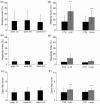Potassium channel antagonists 4-aminopyridine and the T-butyl carbamate derivative of 4-aminopyridine improve hind limb function in chronically non-ambulatory dogs; a blinded, placebo-controlled trial
- PMID: 25551385
- PMCID: PMC4281252
- DOI: 10.1371/journal.pone.0116139
Potassium channel antagonists 4-aminopyridine and the T-butyl carbamate derivative of 4-aminopyridine improve hind limb function in chronically non-ambulatory dogs; a blinded, placebo-controlled trial
Abstract
4-Aminopyridine (4-AP) blocks voltage gated potassium channels, restoring conduction to demyelinated axons and improving function in demyelinating conditions, but its use is associated with adverse effects and benefit in spinal cord injury is limited. Derivatives of 4-AP have been developed to improve clinical efficacy while reducing toxicity. We compared the therapeutic effects of orally administered 4-AP and its t-butyl carbamate derivative (t-butyl) with placebo in dogs that had suffered an acute spinal cord injury that left them chronically paralyzed. Nineteen dogs were entered into the trial, conducted in two-week treatment blocks starting with placebo, followed by random assignment to 4-AP or t-butyl, a washout and then the opposite medication followed by placebo. Investigators and owners were blinded to treatment group. Primary outcome measures included open field gait score (OFS), and treadmill based stepping score and regularity index, with additional secondary measures also considered. Thirteen of 19 dogs completed the protocol. Two were euthanized due to unrelated heath problems, two developed side effects and two were unable to complete for unrelated reasons. Dogs showed significant improvement in supported stepping score (from 17.39 to 37.24% with 4-AP; 16.85 to 29.18% with t-butyl p<0.0001) and OFS (from 3.63 to 4.73 with 4-AP; 3.78 to 4.45 with t-butyl, p = 0.005). Response was individually variable and most dramatic in three dogs that were able to walk without support with treatment. No significant difference was found between 4-AP and t-butyl. No adverse effects were reported with t-butyl but gastrointestinal upset and seizures were observed in two dogs with 4-AP. In conclusion, both 4-AP and t-butyl significantly improved supported stepping ability in dogs with chronic spinal cord injury with no adverse effects noted with t-butyl. Drug response varied widely between individuals, highlighting the need to understand the factors that influence canine and human patients' response to therapy.
Conflict of interest statement
Figures


Similar articles
-
4-Aminopyridine derivatives enhance impulse conduction in guinea-pig spinal cord following traumatic injury.Neuroscience. 2007 Aug 10;148(1):44-52. doi: 10.1016/j.neuroscience.2007.05.039. Epub 2007 Jul 12. Neuroscience. 2007. PMID: 17629412
-
Efficacy and safety of 4-aminopyridine in patients with long-term spinal cord injury: a randomized, double-blind, placebo-controlled trial.Pharmacotherapy. 2003 Jul;23(7):823-34. doi: 10.1592/phco.23.7.823.32731. Pharmacotherapy. 2003. PMID: 12885095 Clinical Trial.
-
Pharmacokinetics of 4-aminopyridine derivatives in dogs.J Vet Pharmacol Ther. 2009 Oct;32(5):485-91. doi: 10.1111/j.1365-2885.2009.01072.x. J Vet Pharmacol Ther. 2009. PMID: 19754916
-
Fampridine-SR for multiple sclerosis and spinal cord injury.Expert Rev Neurother. 2007 May;7(5):453-61. doi: 10.1586/14737175.7.5.453. Expert Rev Neurother. 2007. PMID: 17492896 Review.
-
Clinical overview of dalfampridine: an agent with a novel mechanism of action to help with gait disturbances.Clin Ther. 2012 Nov;34(11):2185-94. doi: 10.1016/j.clinthera.2012.10.003. Epub 2012 Nov 2. Clin Ther. 2012. PMID: 23123001 Review.
Cited by
-
Ambulation in Dogs With Absent Pain Perception After Acute Thoracolumbar Spinal Cord Injury.Front Vet Sci. 2020 Aug 26;7:560. doi: 10.3389/fvets.2020.00560. eCollection 2020. Front Vet Sci. 2020. PMID: 33062648 Free PMC article. Review.
-
Quantifying center of pressure variability in chondrodystrophoid dogs.Vet J. 2017 Aug;226:26-31. doi: 10.1016/j.tvjl.2017.07.001. Epub 2017 Jul 20. Vet J. 2017. PMID: 28911837 Free PMC article.
-
Treatment of Chronic Spinal Cord Injury in Dogs Using Amniotic Membrane-Derived Stem Cells: Preliminary Results.Stem Cells Cloning. 2021 Oct 18;14:39-49. doi: 10.2147/SCCAA.S324184. eCollection 2021. Stem Cells Cloning. 2021. PMID: 34703247 Free PMC article.
-
Emerging and Adjunctive Therapies for Spinal Cord Injury Following Acute Canine Intervertebral Disc Herniation.Front Vet Sci. 2020 Oct 15;7:579933. doi: 10.3389/fvets.2020.579933. eCollection 2020. Front Vet Sci. 2020. PMID: 33195591 Free PMC article. Review.
-
Adaptation of the Basso-Beattie-Bresnahan locomotor rating scale for use in a clinical model of spinal cord injury in dogs.J Neurosci Methods. 2016 Aug 1;268:117-24. doi: 10.1016/j.jneumeth.2016.04.023. Epub 2016 May 4. J Neurosci Methods. 2016. PMID: 27155106 Free PMC article.
References
-
- Kakulas BA (1999) A review of the neuropathology of human spinal cord injury with emphasis on special features. J Spinal Cord Med 22:119–124. - PubMed
-
- Blight AR (1985) Delayed demyelination and macrophage invasion: a candidate for secondary cell damage in spinal cord injury. Cent Nerv Syst Trauma 2(4):299–315. - PubMed
-
- Totoiu MO, Keirstead HS (2005) Spinal cord injury is accompanied by chronic progressive demyelination. J Comp Neurol 13 486(4):373–83. - PubMed
-
- Norenberg MD, Smith J, Marcillo A (2004) The pathology of human spinal cord injury: defining the problems. J Neurotrauma 21:429–440. - PubMed
-
- Guest JD, Hiester ED, Bunge RP (2005) Demyelination and Schwann cell responses adjacent to injury epicenter cavities following chronic human spinal cord injury. Exp Neurol 192:384–393. - PubMed
Publication types
MeSH terms
Substances
LinkOut - more resources
Full Text Sources
Other Literature Sources
Medical

